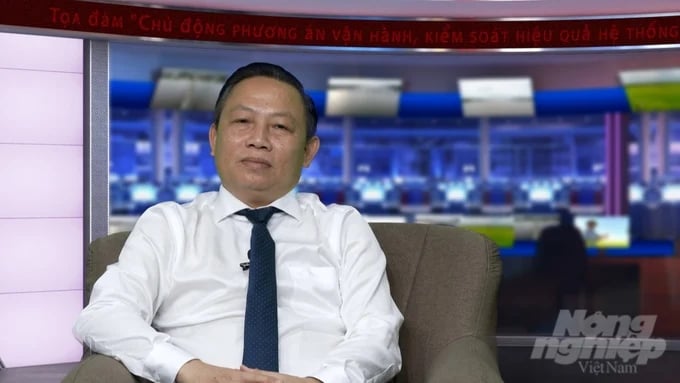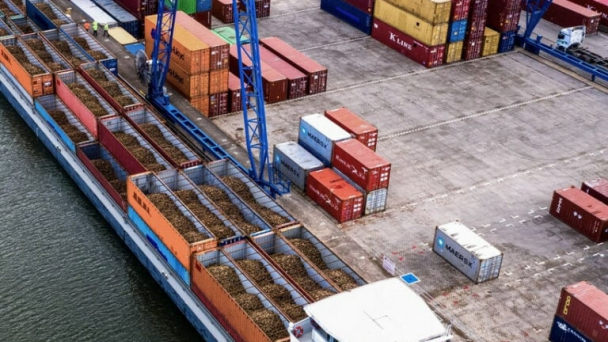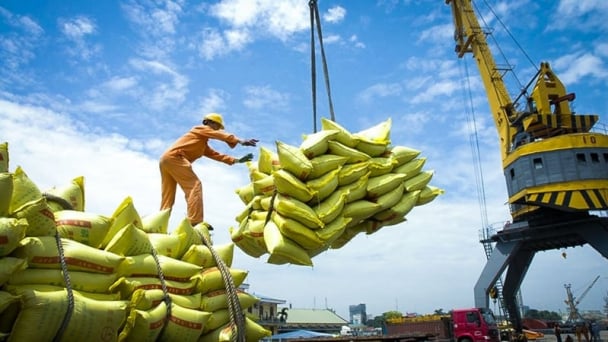May 29, 2025 | 20:49 GMT +7
May 29, 2025 | 20:49 GMT +7
Hotline: 0913.378.918
May 29, 2025 | 20:49 GMT +7
Hotline: 0913.378.918

Associate Professor, Dr Nguyen Phu Quynh, Deputy Director of the Southern Institute of Water Resources Research affirms that the Cai Lon - Cai Be sewer system has been successful in controlling salinity. Photo: Ho Thao.
The Cai Lon - Cai Be sewer project (located in An Bien and Chau Thanh districts, Kien Giang province) is considered a "super" project with a total investment of more than VND 3,300 billion. The project has received many mixed reviews, especially from experts and scientists. However, after a period of receiving criticism and contributions from specialized agencies, considering the pros and cons, the Ministry of Agriculture and Rural Development approved investment in the construction of the above project.'
Nearly 2 years after the date of operation, experts have given some assessments on the effectiveness of the project in a Talkshow conducted by Vietnam Agriculture News. The Talkshow has the topic of "Effectively operate the Cai Lon - Cai Be irrigation system".
According to Associate Professor, Dr. Nguyen Phu Quynh, Deputy Director of the Southern Institute of Water Resources Research, the Cai Lon - Cai Be irrigation system has 3 main tasks. The first task is to regulate water sources and control salinity to ensure stability in rice production and aquaculture for more than 384,000 ha of agricultural land. The second task is to contribute to the prevention and mitigation of natural disasters. The third task is to adapt to climate change to help prevent land subsidence.
Also according to Associate Professor, Dr Nguyen Phu Quynh, over the past year, the weather has been relatively favourable and the drought and salinity have not changed much. As a consequence, the second mission has not been achieved. As for the third task related to adaptation to climate change and land subsidence, it takes time to evaluate its effectiveness.

Operation of Cai Lon - Cai Be sluice brings much efficiency to the agricultural production of the Kien Giang people. Photo: D.T.Chanh.
Deputy Director of the Southern Institute of Water Resources Research affirmed: The Cai Lon - Cai Be sewer system has been successful in controlling salinity, ensuring efficiency and quality in agricultural production, contributing to local economic development and increasing income for farmers. In addition, the sewer irrigation system not only helps save costs on temporary dam construction and does not pollute water sources, but also benefits traffic.
Associate Professor, Dr. Nguyen Phu Quynh, Deputy Director of the Southern Institute of Water Resources Research noted: It is necessary to plan the road and irrigation system to ensure mechanization and reduce transportation costs. At the same time, it is necessary to coordinate the operation of the Cai Lon - Cai Be sewer between localities and levels to ensure the system operates optimally.
According to Mr Le Huu Toan, Deputy Director of the Department of Agriculture and Rural Development of Kien Giang province, after nearly 2 years of operating the Cai Lon - Cai Be sluice gate, the sluice brings many positive effects on agricultural production. Specifically, in terms of eco-tourism development, conversion from rice farming to aquaculture and infrastructure have also been upgraded.
To optimize water source control of the Cai Lon - Cai Be sewer system, it is necessary to improve the infrastructure. Currently, there are 11 sewer projects that need to be invested in to operate synchronously with the Cai Lon - Cai Be sewer cluster. Kien Giang province has asked for central capital and proposed investment in other projects.

Mr. Nguyen Huu Toan, Deputy Director of the Department of Agriculture and Rural Development of Kien Giang province participated in the Talk show organized by Vietnam Agriculture News at N3 Studio. Photo: Ho Thao.
Mr. Toan emphasized that propaganda will help people understand the main goal of the Cai Lon - Cai Be project is to control salty and sweet water. The project goals are to stabilize production models and develop livelihoods, not prevent salinity. Accordingly, propaganda also focuses on properly implementing the seasonal calendar and organizing effective seasonal production.
Deputy Director of the Department of Agriculture and Rural Development of Kien Giang province hopes that the people of Kien Giang province and neighbouring provinces will follow the production plan to take full advantage of the benefits that the Cai Lon - Cai Be irrigation system brings about.
Translated by Hoang Duy

(VAN) The mutual export of agrifood products between the European Union (EU) and the United Kingdom (UK) must occur again without certification, border controls or other red tape. This was agreed at the UK-EU summit.
/2025/05/22/5121-2-173645_677.jpg)
(VAN) NBSAP Tracker identifies strengths and areas for improvement in the National Biodiversity Strategy, based on each region’s priorities and capacities.

(VAN) The draft amendment to the Circular on rice export trading stipulates a periodic reporting regime for rice exporting enterprises.

(VAN) Dong Thap farmers attained an average profit margin of 64% during the summer-autumn 2024 crop (first season), while An Giang and Kien Giang farmers followed with 56% and 54%, respectively.

(VAN) As a doctoral student doing research on renewable energy and electrification at Harvard University, the author shares his musings on electricity, nature, and countryside memories.

(VAN) The decree on Extended Producer Responsibility (EPR) ensures transparent management and disbursement of support funds, avoiding the creation of a “give-and-take” mechanism.

(VAN) Hue City rigorously enforces regulations regarding marine fishing and resource exploitation, with a particular emphasis on the monitoring of fishing vessels to prevent illegal, unreported, and unregulated (IUU) fishing.